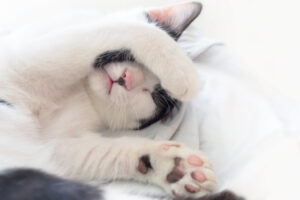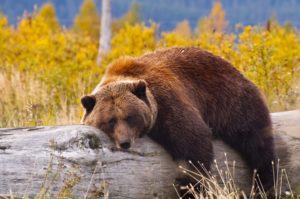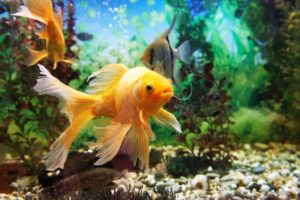How Do Animals Sleep?
Have you ever wondered how whales can sleep without drowning, or why bats sleep upside down? All animals need sleep, but animal sleep patterns are as varied as the animal kingdom itself.
How Mammals Sleep
Mammals sleep to save their energy and restore mental and physical energy. The amount of sleep a mammal needs depends on several factors, including age, body size, environment, diet, and the safety of its sleep site. Whether a mammal lives on land or in the sea can also affect how much sleep it needs.
Different mammals spend different amounts of time in non-REM sleep and REM sleep. However, all mammals studied thus far do exhibit signs of REM sleep, suggesting that mammals dream , just like humans do.
Mammalian sleep is often categorized as monophasic or polyphasic. Monophasic sleep describes animals who generally receive their sleep in one concentrated time period. Humans are an example of monophasic sleepers. Our circadian rhythms encourage us to sleep for extended periods at night and be active and alert during the day.
Polyphasic sleepers, on the other hand, tend to sleep in multiple periods throughout a 24-hour cycle. Polyphasic sleep is more common, as many animals need to maintain some level of vigilance against predators. However, if threats are minimized, animals can enjoy monophasic sleep. Marmosets, for example, sleep in trees surrounded by their family, enabling them to feel more protected and experience monophasic sleep.
Land Mammals
Even within land mammals, the amount of sleep required varies from species to species. Giraffes need surprisingly little sleep. The average giraffe sleeps for 4.6 hours per day . For the most part, giraffes tend to sleep during the night, although they do get in some quick naps throughout the day. Giraffes can sleep standing up as well as lying down, and their sleep cycles are quite short, lasting 35 minutes or shorter.
Elephants are another animal that sleep very little. Some researchers have documented their total sleep time at just 2 hours per day . Scientists can tell elephants are sleeping when their trunks stop moving. Elephants, like giraffes, likely only sleep for a few hours each day due to their massive body size and need to graze often. Predation risk may also play a role in how little they sleep, given how far they’ll travel while awake. Scientists have observed elephants traveling for nearly two days without sleeping at all.
Like giraffes and elephants, horses don’t sleep much, and when they do, they can sleep standing up. However, once they enter REM sleep, they lie down.
On the other end of the spectrum, there are dogs, who spend over a third of their day asleep . Another 21% of their day is spent in a state of relaxed drowsiness, ready to nap at a moment’s notice. Little brown bats sleep even longer, at about 20 hours per day. Some of that time is spent in a state of torpor, or hibernation.
What Is Hibernation?
Hibernation is a sleep-like state many mammals and some other types of animals engage in. During hibernation, which can last months at a time, an animal eats, moves, and produces waste very infrequently and only during brief periods of mild arousal.
There’s a common misconception of hibernation as an extended sleep state, but that’s not quite correct. Hibernation is more properly understood as a state of torpor. During torpor, animals have a lowered metabolism , heart rate, body temperature, and respiratory rate. These effects are similar to what happens during sleep, but they’re more pronounced during hibernation than in normal sleep.
Animals hibernate to conserve energy during severe temperature changes or when food is scarce. Bats, for example, must decide whether to hibernate or migrate when their food supply of insects dwindles in the colder months. Some bats may stick around, conserving their energy by entering torpor for a few hours on a chilly day, or hibernating for six months until insects return in the spring.
When people think of hibernation, they frequently think of bears — although the hibernation bears experience is unique from typical hibernation . During torpor, a bear’s body temperature stays nearly the same, although it won’t eat, drink, urinate, or defecate much for a period of up to seven months. Other animals that hibernate include the Madagascan fat-tailed dwarf lemur , European hedgehogs , ground squirrels, and pygmy possums .

Marine Mammals
When it comes to sleep duration, walruses are like the bats of the sea, sleeping between 19.4 to 20.5 hours per day. They can sleep in water and on land, although they sleep for longer periods on land . When walruses sleep in the water, they usually lie at the bottom, float along the surface, or lean against something while in a standing position. They can even hook their tusks onto an ice floe and sleep that way. Like elephants, walruses can go for days without sleep. They can swim for up to 84 hours before needing to recharge.
Not to be outdone by walruses, sperm whales also have unique sleeping positions. They actually sleep in an upright position . Watchful scientists were able to confirm they were asleep because they didn’t react to a ship passing by until it bumped into them!
Dolphins, eared seals, and manatees are all marine mammals who sleep unihemispherically . During unihemispheric sleep, one side of the brain sleeps while the other side stays awake, enabling these animals to enjoy the restorative benefits of sleep while still being on the lookout for potential threats.
Birds
Birds also sleep unihemispherically, with one side of the brain asleep while the other stays awake. As they sleep, only the eye associated with the sleeping hemisphere of their brain is closed.
Unihemispheric sleep allows birds to protect themselves from predators. For example, mallard ducks can sleep in a row. The ducks at the end will be most likely to sleep unihemispherically, with their outward eye remaining open, while ducks in the middle sleep with both eyes closed.
Unihemispheric sleep also enables migratory birds to make their long flights. They may sleep while gliding, when their wings don’t need to flap as much. Birds like the Alpine swift have been documented flying for 200 days non-stop .
However, migrating birds do sleep significantly less while migrating. White-crowned sparrows, for instance, only get a third of the sleep they do when they’re not migrating. They’ll catch up on sleep with daytime micro-naps, and during times when they’re perched. When they perch, tendons in their feet lock into place , allowing them to sleep with little exertion. Bats have a similar locking function which enables them to sleep upside down.
Reptiles and Amphibians
Reptiles and amphibians are some of the least studied animals when it comes to sleep. Historically, REM and slow-wave sleep were thought to exclusively be sleep patterns of mammals and birds. However, emerging research indicates that reptiles such as lizards may also experience these stages of sleep, even in sleep cycles as short as 80 seconds .
Like other animals, lizards choose sleep perches that maximize their safety. They may sleep on leaves, with their heads oriented towards the path a predator would use to approach them . Some predators, like crocodiles , sleep unihemispherically so they can keep an eye out for threats and food.
While crocodiles sleep with one eye open, snakes sleep with both eyes open — in fact, they must, since they don’t have eyelids. Snakes may sleep for days at a time, digesting their food.
Cottonmouth snakes and Western fence lizards both brumate. Similar to hibernation, brumation describes a state of reduced activity and metabolism in reptiles, typically in response to colder temperatures and less available food. Salamanders can enter brumation for 100 days at a time .
Amphibians can also enter a state of torpor to survive in arid climates. This state is known as estivation . During estivation, green-striped burrowing frogs burrow deep underground, where they stop moving and eating for months.
Do Fish Sleep?
Sort of, but it’s probably more appropriate to call what fish do “rest.” When fish are resting, they slow down their activity level and metabolism while remaining alert enough to protect themselves from danger. They float in place, like zebrafish do , or find themselves a safe spot in the mud, sand, or coral to rest. Parrotfish even secrete a cocoon of mucus around themselves to stay protected while they sleep.
The way a shark sleeps depends on how it breathes. Buccal pumping sharks breathe through their cheeks, which allows them to rest motionless in a cave or on the sea bottom. Scientists have observed nurse sharks, a type of buccal pumping shark, entering a sleep-like state in which they appear sluggish and still. Their eyes are half-closed, and their pectoral and tail fins prop them up as they use a rock for a pillow.
Ram ventilating fishes and sharks, on the other hand, ventilate their gills by keeping their mouths open while they swim. They must swim continuously, so they have to find creative ways to sleep. Scientists hypothesize that ram ventilating fishes may take advantage of currents, allowing the current to push water over their gills and enable respiration. It is more likely, however, that they sleep unihemispherically, enabling one eye to stay open and monitor their environment.

Still have questions? Ask our community!
Join our Sleep Care Community — a trusted hub of sleep health professionals, product specialists, and people just like you. Whether you need expert sleep advice for your insomnia or you’re searching for the perfect mattress, we’ve got you covered. Get personalized guidance from the experts who know sleep best.
References
28 Sources
-
Siegel J. M. (2005). Clues to the functions of mammalian sleep. Nature, 437(7063), 1264–1271.
https://pubmed.ncbi.nlm.nih.gov/16251951/ -
Staunton H. (2005). Mammalian sleep. The Science of Nature, 92(5), 203–220.
https://pubmed.ncbi.nlm.nih.gov/15843983/ -
Ishikawa, A., Sakai, K., Maki, T., Mizuno, Y., Niimi, K., Oda, Y., & Takahashi, E. (2017). Investigation of sleep-wake rhythm in non-human primates without restraint during data collection. Experimental Animals, 66(1), 51–60.
https://pubmed.ncbi.nlm.nih.gov/27760892/ -
Tobler, I., & Schwierin, B. (1996). Behavioural sleep in the giraffe (Giraffa camelopardalis) in a zoological garden. Journal of Sleep Research, 5(1), 21–32.
https://pubmed.ncbi.nlm.nih.gov/8795798/ -
Gravett, N., Bhagwandin, A., Sutcliffe, R., Landen, K., Chase, M. J., Lyamin, O. I., Siegel, J. M., & Manger, P. R. (2017). Inactivity/sleep in two wild free-roaming African elephant matriarchs – Does large body size make elephants the shortest mammalian sleepers? PLoS One, 12(3), e0171903.
https://pubmed.ncbi.nlm.nih.gov/28249035/ -
Lucas, E. A., Powell, E. W., & Murphree, O. D. (1977). Baseline sleep-wake patterns in the pointer dog. Physiology & Behavior, 19(2), 285–291.
https://pubmed.ncbi.nlm.nih.gov/203958/ -
Commonwealth of Massachusetts. (2020, September 28). Species spotlight: Little brown bat. Mass.Gov., Retrieved February 12, 2021 from
https://www.mass.gov/news/species-spotlight-little-brown-bat -
Bouma, H. R., Carey, H. V., & Kroese, F. G. (2010). Hibernation: The immune system at rest?. Journal of Leukocyte Biology, 88(4), 619–624.
https://pubmed.ncbi.nlm.nih.gov/20519639/ -
National Park Service. (2020, June 12). Hibernate or migrate. National Park Service., Retrieved February 12, 2021 from
https://www.nps.gov/subjects/bats/hibernate-or-migrate.htm -
Nelson R. A. (1980). Protein and fat metabolism in hibernating bears. Federation Proceedings, 39(12), 2955–2958.
https://pubmed.ncbi.nlm.nih.gov/6998737/ -
Dausmann, K. H., Glos, J., Ganzhorn, J. U., & Heldmaier, G. (2004). Physiology: Hibernation in a tropical primate. Nature, 429(6994), 825–826.
https://pubmed.ncbi.nlm.nih.gov/15215852/ -
South, K. E., Haynes, K., & Jackson, A. C. (2020). Hibernation Patterns of the European Hedgehog, Erinaceus europaeus, at a Cornish Rescue Centre. Animals, 10(8), 1418.
https://pubmed.ncbi.nlm.nih.gov/32823861/ -
Melvin, R. G., & Andrews, M. T. (2009). Torpor induction in mammals: Recent discoveries fueling new ideas. Trends in Endocrinology and Metabolism, 20(10), 490–498.
https://pubmed.ncbi.nlm.nih.gov/19864159/ -
Lyamin, O. I., Kosenko, P. O., Vyssotski, A. L., Lapierre, J. L., Siegel, J. M., & Mukhametov, L. M. (2012). Study of sleep in a walrus. Doklady Biological Sciences, 444, 188–191.
https://pubmed.ncbi.nlm.nih.gov/22760621/ -
Pryaslova, J. P., Lyamin, O. I., Siegel, J. M., & Mukhametov, L. M. (2009). Behavioral sleep in the walrus. Behavioural Brain Research, 201(1), 80–87.
https://pubmed.ncbi.nlm.nih.gov/19428620/ -
Miller, P. J., Aoki, K., Rendell, L. E., & Amano, M. (2008). Stereotypical resting behavior of the sperm whale. Current Biology, 18(1), R21–R23.
https://pubmed.ncbi.nlm.nih.gov/18177706/ -
Mascetti G. G. (2016). Unihemispheric sleep and asymmetrical sleep: behavioral, neurophysiological, and functional perspectives. Nature and Science of Sleep, 8, 221–238.
https://pubmed.ncbi.nlm.nih.gov/27471418/ -
Liechti, F., Witvliet, W., Weber, R., & Bächler, E. (2013). First evidence of a 200-day non-stop flight in a bird. Nature Communications, 4, 2554.
https://pubmed.ncbi.nlm.nih.gov/24104955/ -
Quinn, T. H., & Baumel, J. J. (1993). Chiropteran tendon locking mechanism. Journal of Morphology, 216(2), 197–208.
https://pubmed.ncbi.nlm.nih.gov/8515478/ -
Shein-Idelson, M., Ondracek, J. M., Liaw, H. P., Reiter, S., & Laurent, G. (2016). Slow waves, sharp waves, ripples, and REM in sleeping dragons. Science), 352(6285), 590–595.
https://pubmed.ncbi.nlm.nih.gov/27126045/ -
Mohanty, N. P., Harikrishnan, S., & Vasudevan, K. (2016). Watch out where you sleep: Nocturnal sleeping behaviour of Bay Island lizards. PeerJ, 4, e1856.
https://pubmed.ncbi.nlm.nih.gov/27168958/ -
Kelly, M. L., Peters, R. A., Tisdale, R. K., & Lesku, J. A. (2015). Unihemispheric sleep in crocodilians?. The Journal of Experimental Biology, 218(Pt 20), 3175–3178.
https://pubmed.ncbi.nlm.nih.gov/26491191/ -
Texas Parks and Wildlife Department. (n.d.). Sleep and Hibernation. Texas Parks and Wildlife., Retrieved February 8, 2021, from
https://tpwd.texas.gov/publications/nonpwdpubs/young_naturalist/animals/sleep_and_hibernation/ -
Wilkinson, A., Hloch, A., Mueller-Paul, J., & Huber, L. (2017). The effect of brumation on memory retention. Scientific Reports, 7, 40079.
https://pubmed.ncbi.nlm.nih.gov/28074838/ -
Reilly, B. D., Schlipalius, D. I., Cramp, R. L., Ebert, P. R., & Franklin, C. E. (2013). Frogs and estivation: Transcriptional insights into metabolism and cell survival in a natural model of extended muscle disuse. Physiological Genomics, 45(10), 377–388.
https://pubmed.ncbi.nlm.nih.gov/23548685/ -
Kelly, M. L., Collin, S. P., Hemmi, J. M., & Lesku, J. A. (2019). Evidence for sleep in sharks and rays: Behavioural, physiological, and evolutionary considerations. Brain, Behavior and Evolution, 94(1–4), 37–50.
https://pubmed.ncbi.nlm.nih.gov/31775150/ -
Oxford University Press. (n.d.). Buccal force pump. Oxford Reference., Retrieved February 8, 2021, from
https://www.oxfordreference.com/view/10.1093/oi/authority.20110803095533759 -
Oxford University Press. (n.d.). Ram ventilation. Oxford Reference., Retrieved February 8, 2021, from
https://www.oxfordreference.com/view/10.1093/oi/authority.20110803100403496








